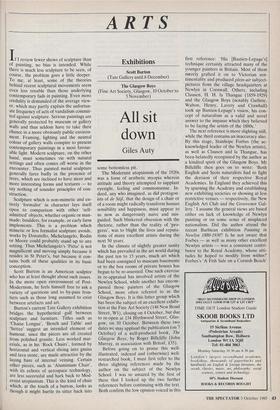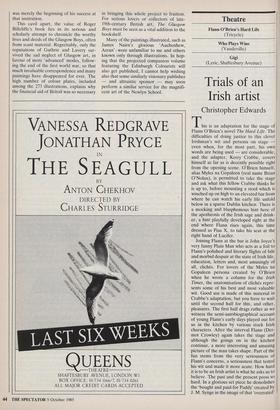ARTS
Exhibitions
Scott Burton (Tate Gallery until 8 December) The Glasgow Boys (Fine Art Society, Glasgow, 10 October to 5 November)
All sit down
Giles Auty
If I review fewer shows of sculpture than of painting, no bias is intended. While there is much less sculpture to be seen, of course, the problem goes a little deeper. To me, at least, some of the theories behind recent sculptural movements seem even less tenable than those underlying contemporary fads in painting. Even more credulity is demanded of the average view- er, which may partly explain the unfortun- ate frequency of acts of vandalism commit- ted against sculpture. Serious paintings are generally protected by museum or gallery walls and thus seldom have to take their chance in a more obviously public environ- ment. Framing, lighting and the neutral colour of gallery walls conspire to present contemporary paintings in a most favour- able light. Modern sculpture, on the other hand, must sometimes vie with natural settings and often comes off worse in the encounter. Thus painted metal sculpture generally fares badly in the presence of trees, which are inclined to have nicer and more interesting forms and textures — to say nothing of sounder principles of con- struction.
Sculpture which is non-mimetic and en- tirely 'formalist' in character lays itself open to comparison with other 'self- admitted' objects, whether organic or man- made: boulders, for example, or early farm implements. This is a problem which mimetic or less formalist sculpture avoids; works by Donatello, Michelangelo, Rodin or Moore could probably stand up to any setting. Thus Michelangelo's `Pieta' is not magnificent and moving simply because it resides in St Peter's, but because it con- tains both of these qualities in its basic conception.
Scott Burton is an American sculptor who has at least thought about such issues. In the more open environment of Post- Modernism, he feels himself free to ask a variety of questions and to by-pass fron- tiers such as those long assumed to exist between artefacts and art.
Burton's current Tate Gallery exhibition bridges the hypothetical gulf between sculpture and furniture. Titles such as `Chaise Longue', 'Bench and Table' and `Settee' suggest an intended element of humour, since the pieces are all created from polished granite. Less worked mat- erials, as in his 'Rock Chairs', formed by horizontal and vertical slicing into gneiss and lava stone, are made attractive by the laying bare of internal veining. Certain other pieces, such as 'Aluminium Chair', with its echoes of aerospace technology, are less successful and hark back to Mod- ernist utopianism. This is the kind of chair which, at the touch of a button, looks as though it might hurtle its sitter back into some bottomless pit.
The Modernist utopianism of the 1920s was a form of aesthetic myopia wherein attitude and theory attempted to supplant eyesight, feeling and commonsense. In- deed, any who imagined, as did protagon- ists of de Stijl, that the design of a chair or of a room might radically transform human sensibility and happiness, must appear to us now as dangerously naive and mis- guided. Such blinkered obsession with the rhetoric, rather than the reality of 'pro- gress', was to blight the lives and reputa- tions of many excellent artists during the next 50 years.
In the climate of slightly greater sanity which has prevailed in the art world during the past ten to 15 years, much art which had been consigned to museum basements or to the box rooms of private houses has begun to be re-assessed. One such exercise in re-appraisal has involved artists of the Newlyn School, while another has encom- passed those painters of the Glasgow School, more often referred to as the Glasgow Boys. It is this latter group which has been the subject of an excellent exhibi- tion at the Fine Art Society (148 New Bond Street, W1), closing on 4 October, but due to re-open at 134 Blythwood Street, Glas- gow, on 10 October. Between these two dates we may applaud the publication (on 7 October) of a well-produced book, The Glasgow Boys, by Roger Billcliffe (John Murray, in association with Britoil, £35).
Before going on to praise this well- illustrated, indexed and (otherwise) well- researched book, I must first refer to the three slighting references made by the author on the subject of the Newlyn School. I was so amazed by the first of these that I looked up the two further references before continuing with the text. Both confirm the low opinion voiced in this
first reference: 'His [Bastien-Lepage's] technique certainly attracted many of the younger painters in Britain. Most of them merely grafted it on to Victorian sen- timentality and produced plein-air subject- pictures from the village headquarters at Newlyn in Cornwall. Others, including Clausen, H. H. la Thangue (1859-1929) and the Glasgow Boys (notably Guthrie, Walton, Henry, Lavery and Crawhall) took up Bastien-Lepage's vision, his con- cept of naturalism as a valid and novel answer to the impasse which they believed to be facing the artists of the 1880s.'
The next reference is more slighting still, while the third contains an inaccuracy also. By this stage, Stanhope Forbes (the ac- knowledged leader of the Newlyn artists), as well as Clausen and la Thangue, has been belatedly recognised by the author as a kindred spirit of the Glasgow Boys. Mr Billcliffe then goes on to write: 'Both English and Scots naturalists had to fight the derision of their respective Royal Academies. In England they achieved this by spurning the Academy and establishing new exhibiting societies or showing at less restrictive venues — respectively, the New English Art Club and the Grosvenor Gal- lery.' I assume the general views are based either on lack of knowledge of Newlyn painting or on some sense of misplaced nationalism. Did the author attend the recent Barbican exhibition Painting in Newlyn 1880-1930? Is he not aware that Forbes — as well as many other excellent Newlyn artists — was a consistent contri- butor to the Royal Academy, whose atti- tudes he hoped to modify from within? Forbes's 'A Fish Sale on a Cornish Beach'
was merely the beginning of his success at that institution.
This cavil apart, the value of Roger Bilicliffe's book lies in its serious and scholarly attempt to chronicle the worthy lives and deeds of the Glasgow Boys, often from scant material. Regrettably, only the reputations of Guthrie and Lavery sur- vived the sad neglect of Glasgow art, in favour of more 'advanced' modes, follow- ing the end of the first world war, so that much invaluable correspondence and many paintings have disappeared for ever. The high number of colour plates, included among the 273 illustrations, explains why the financial aid of Britoil was so necessary
in bringing this whole project to fruition. For serious lovers or collectors of late- 19th-century British art, The Glasgow Boys must be seen as a vital addition to the bookshelf.
Many of the paintings illustrated, such as James Nairn's glorious `Auchenhew, Arran', were unfamiliar to me and others known only through illustrations. In hop- ing that the projected companion volume featuring the Edinburgh Colourists will also get published, I cannot help wishing also that some similarly visionary publisher — and altruistic sponsor — may soon perform a similar service for the magnifi- cent art of the Newlyn School.



























































 Previous page
Previous page